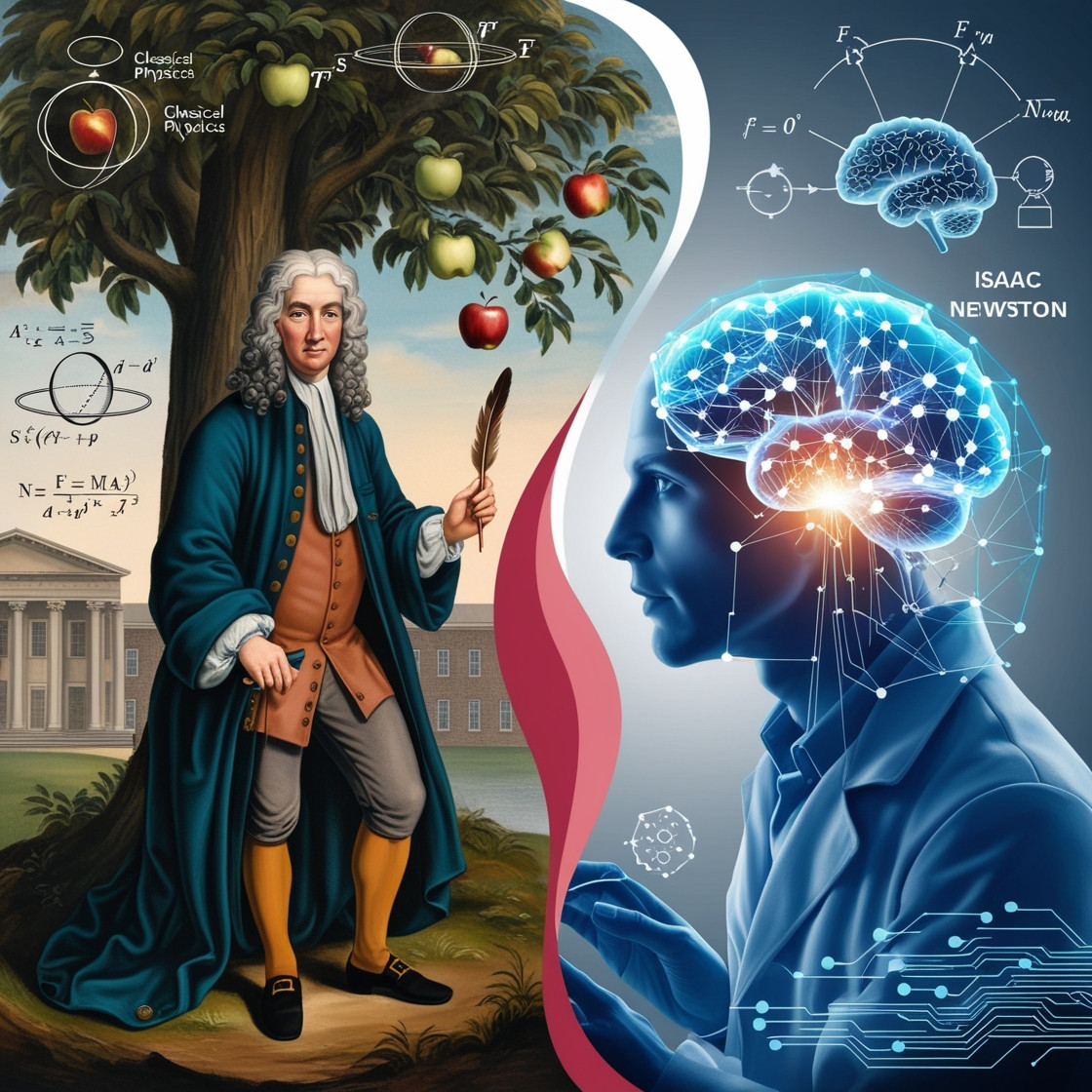Introduction: Bridging Centuries of Discovery
:. But now, as we stand on the cusp of a new era, a different kind of force is driving the field forward—Artificial Intelligence (AI). This blog takes you on a journey through the history of physics, highlighting how AI is not just a tool, but a transformative force that is redefining how we understand the physical world.
The Legacy of Classical Physics: From Newton to Maxwell
Isaac Newton’s work in the 17th century laid the foundation for classical physics. His laws of motion and universal gravitation described a universe that operated like a well-oiled machine. These principles allowed scientists to predict the movement of planets, the behavior of objects on Earth, and even the flow of time itself.
Later, James Clerk Maxwell’s equations unified electricity, magnetism, and light, giving us the classical theory of electromagnetism. These equations didn’t just revolutionize physics—they paved the way for modern technology, including telecommunications and electrical engineering.
However, as powerful as these theories were, they had limitations. Newton’s laws couldn’t explain the behavior of particles at very small scales, nor could they account for the complexities of chaotic systems. That’s where AI comes in, providing a new lens through which to view these classical theories and solve problems that have stumped scientists for centuries.
The Birth of AI: A New Tool for Old Problems
Artificial Intelligence emerged in the mid-20th century as a discipline focused on creating machines capable of mimicking human intelligence. Initially, its applications were confined to tasks like playing chess or solving mathematical equations. But as AI evolved, so did its potential uses in scientific research.
Today, AI is being used to tackle some of the most complex problems in classical physics. For example, Newton’s equations describe how objects move under the influence of forces, but they become incredibly difficult to solve when applied to systems with many interacting parts, like weather patterns or planetary orbits. AI can analyze vast amounts of data from these systems, finding patterns and making predictions that would be impossible with traditional methods.
One such application is in the study of chaotic systems. While Newton’s laws are deterministic, meaning they predict a single outcome given a set of initial conditions, chaotic systems are highly sensitive to those conditions. Small changes can lead to vastly different outcomes, making long-term predictions nearly impossible. AI, with its ability to process and analyze large datasets, is helping physicists make sense of these systems, finding order in chaos.
AI and the Reinvention of Classical Theories
One of the most fascinating developments in recent years is how AI is being used to revisit and refine classical theories. For instance, neural networks—a type of AI modeled on the human brain—are being used to simulate physical systems and even discover new laws of physics.
A compelling example is the application of AI in solving the famous three-body problem. This problem, which involves predicting the motion of three celestial bodies based on their gravitational interactions, has puzzled physicists since Newton’s time. Traditional methods struggle with the complexity, but AI can simulate countless scenarios, finding solutions that were previously out of reach.
AI is also aiding in the field of fluid dynamics, where it’s being used to solve the Navier-Stokes equations—an unsolved problem in classical physics that describes the motion of fluid substances. By training on vast amounts of data, AI algorithms are helping to model and predict fluid behavior more accurately than ever before, with applications ranging from aerodynamics to climate science.
The Future of Physics: AI as a Collaborative Partner
As AI continues to develop, its role in physics is shifting from that of a mere tool to a collaborative partner in discovery. It’s not just about solving equations faster; AI is now being used to identify new physical laws and principles that could lead to entirely new fields of study.
For example, AI is being used in the search for new materials with specific properties. By analyzing the atomic structures of countless compounds, AI can predict how these materials will behave under different conditions, potentially leading to breakthroughs in everything from superconductors to renewable energy sources.
Moreover, AI is helping to unlock the secrets of quantum mechanics, a field that classical physics couldn’t fully explain. Quantum systems are notoriously difficult to simulate due to their complexity, but AI is making it possible to explore these systems in ways that were previously unimaginable.
Conclusion: A New Era of Discovery
The intersection of classical physics and AI represents a new era of discovery. While Newton’s laws and Maxwell’s equations laid the groundwork for our understanding of the universe, AI is taking us to the next level, solving problems that have stumped scientists for centuries and uncovering new mysteries along the way.
As we look to the future, it’s clear that the partnership between physics and AI will continue to deepen, leading to discoveries that we can only begin to imagine. Whether it’s finding order in chaotic systems, predicting the behavior of new materials, or unlocking the secrets of the quantum world, AI is poised to revolutionize our understanding of the universe in ways that Newton and his contemporaries could have never anticipated.
In this new era, the boundaries between classical physics and AI are blurring, leading to a future where machines don’t just follow physical laws—they help us discover them.


0 Comment